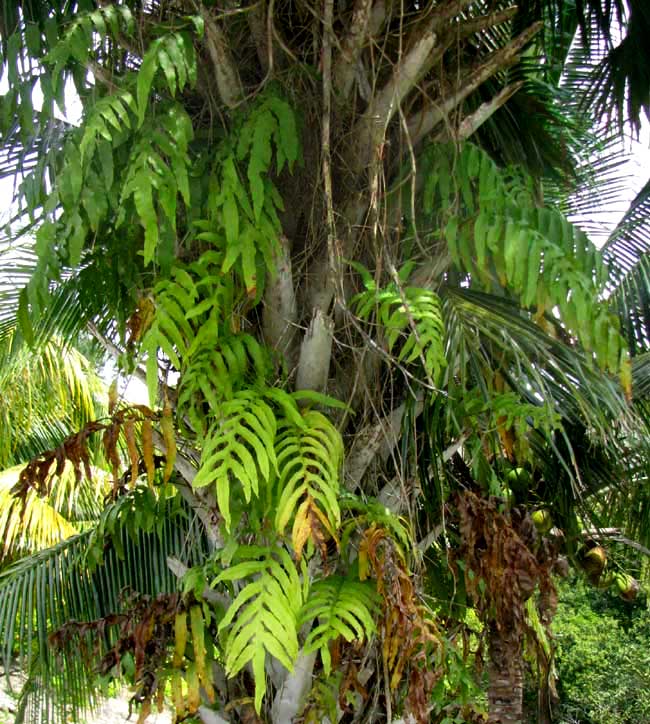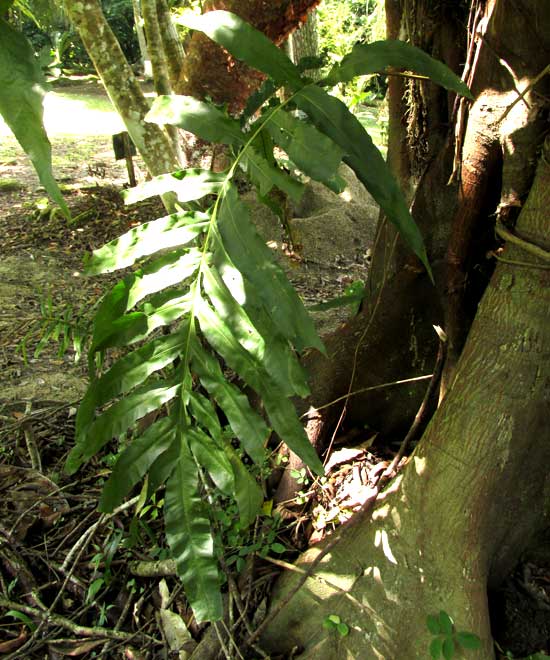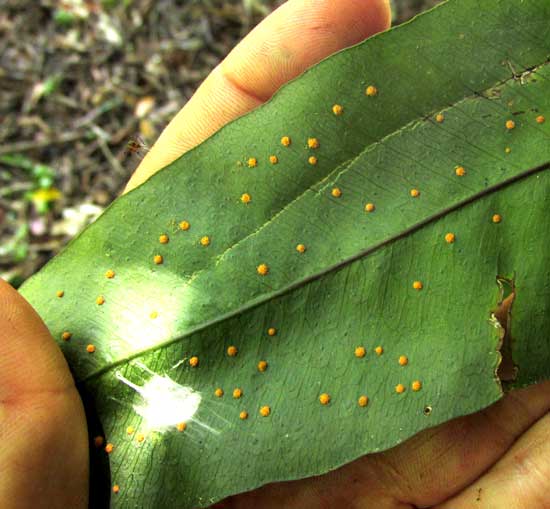Excerpts from Jim Conrad's
Naturalist Newsletter

from the March 4, 2012 Newsletter issued from Hacienda Chichen Resort beside Chichén Itzá Ruins; limestone bedrock; elevation ~39m (~128ft), N20.675°, W88.569°; central Yucatán state, MÉXICO
CALAGUALA FERN
In an abandoned lot on a backstreet of Dzitas, several Huano Thatch Palms cast cool, pleasing shade. On Huano trunks, the stiff petioles of old fronds remain long after the fronds have broken off, making the trunks look bristly and raggedy. Over time, organic and inorganic detritus collects in the angles between the old petioles and the trunks, forming a kind of soil. Plants can root in that airborne palm-trunk soil, animals can take up residence there, and other organisms can come to create whole palm-trunk ecosystems.
On this particular backstreet in Dzitas, most older Huano palm-trunk ecosystems hosted a fern species I've not seen elsewhere in the Yucatán, as shown at the top of this page.
Luckily, several frond segments bore spore-producing sori, or "fruit dots," needed for identification, seen below:

Not many kinds of ferns have their sori scattered across their fronds' broad undersurfaces like that. Among ferns up North the only ones with sori looking a little like this are the Polypodies, genus Polypodium. In fact, our Huano-trunk fern species has sometimes been placed in the genus Polypodium, but nowadays most experts assign it to Phlebodium -- it's PHLEBODIUM DECUMANUM.
And that's interesting because I don't find Phlebodium decumanum listed for the Yucatán. It occurs from southern Mexico south deep into South America, but I am surprised to find it growing under such relatively arid conditions as here.
Finding Phlebodium decumanum here also is interesting because its fronds and rhizomes are regarded by many as medicinal. However, there's little agreement about what they're medicinal for. You can find claims that they're good for everything from whooping cough and fever to joint pain, blood needing cleansing, dermatitis, problems of the pancreas... on and on.
But, maybe there's something to the claims. Clinical research involving various double-blind placebo human trials found that a water extract from the fern was "an effective treatment for psoriasis --as well as dermatitis and vitiligo (with a 3-6 month course of treatment required)."
A common Spanish name for the fern is Calaguala. In Brazil they call it Samambaia. Medicines based on the fern are often marketed under those names.
from the November 16, 2018 Newsletter with notes from a camping trip into the Petén District of northern GUATEMALA
CALAGUALA IN THE SHADE
Last September 31, during my camping trip into northern Guatemala's Petén district, in the campground of Rosario National Park on the east side of the town of Sayaxché, a leg-long fern frond arising from a slender, densely hairy rhizome crawling up a tree trunk caught my eye. You can see it below:

Ferns reproduce by means of microscopic spores, and spores are produced in stalked, baglike "sporangia," which themselves are nearly microscopic. These sporangia often are gathered in small "sori," which sometimes are called fruitdots. Fruitdots on the undersurface of this frond were unusual, as shown below:

The "classic fruitdot" is elongated like a fingernail clipping, often curved, and is partly covered on one side by a narrow, cellophane-like "indusium." Normally fruitdots are arranged in some kind of pattern. Therefore, the fruitdots in the above picture are a little unusual in that they're simply round dots with no indusium, and they're seemingly randomly scattered.
We've seen this fern before, in the much more arid northern Yucatan Peninsula, where it was uncommon {above entry}. On that fern's fronds the fruitdots were much more numerous and ordered. Also, the undersurface was golden colored. The blade was golden because it was old and fading, and I suppose its numerous, well ordered fruitdots result from having plenty of sunlight. Our Guatemalan fern was in deep shade and not nearly as vigorous looking as the one on the above page.
So this shows how a species can vary in its appearance, though the more technical details of fruitdot size, shape and lack of indusium remain the same.